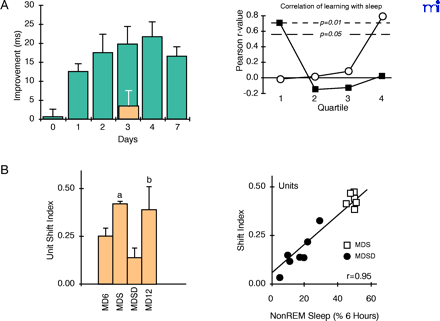
- Institution: Stanford Univ Med Ctr Lane Med Lib/Periodical Dept/Rm L109
- Sign In as Member / Individual
Reciprocal Interaction of Sleep and Synaptic Plasticity

Sleep-dependent improvement of learning and plasticity. A. The improvement of texture discrimination depends on the first night of sleep. (Left): Time course of improvement. Each subject was trained then tested once. Each bar represents a separate group of subjects. Blue bars: control group. Tan bar: subjects deprived of sleep for 30 hours after training and then tested after recovery sleep. (Right): Correlation of learning with SWS and REM sleep across the first night after training. Pearson correlation coefficients between amounts of SWS in each quartile and overnight improvement (filled squares) or for amounts of REM (open circles). Note early SWS and late REM sleep correlate with improved learning. Adapted from Stickgold et al. (17, 18). B. Ocular dominance shift is hampered by sleep deprivation in cats. (Right): Ocular dominance shift of each experimental group. MD6: Kittens assessed immediately after 6 hours monocular deprivation (MD). MDS: 6 hours of MD followed by 6 hours of ad libitum sleep in the dark; MDSD: 6 hours of MD followed by 6 hours of sleep deprivation in the dark; MD12: 12 hours MD. (Left): High correlation between changes in ocular dominance and amounts of SWS in the dark. Adapted from Frank et al. (26).


